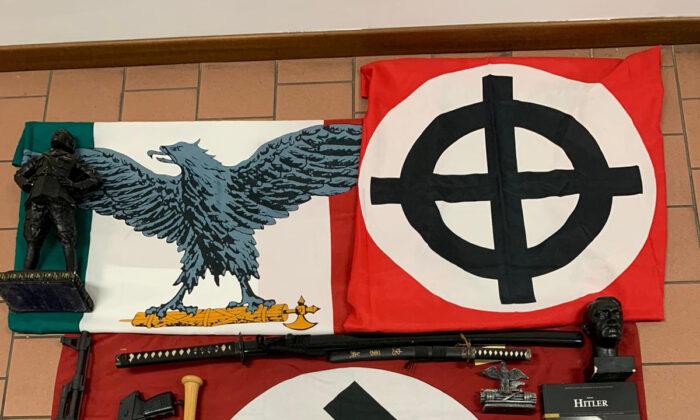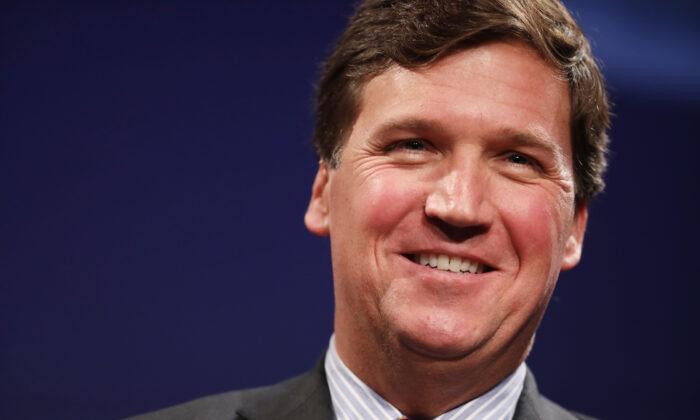Investigator Roger Charles was combing through records of the FBI’s Oklahoma City bombing investigation more than a decade ago, when he discovered a memo suggesting that someone working at ABC News provided a tip to the bureau a day after the deadly April 19, 1995, domestic terrorist attack.
However, Charles’s discovery stoked the curiosity of his friend, attorney Jesse Trentadue. At that time, Trentadue, a Utah resident, was suing the FBI for records related to his brother’s murder, and he began filing requests in 2012 to see if the bureau had other informants in the media, or in places such as congressional offices, courts, churches, other government agencies, and the White House.
Trentadue said the government’s response shocked him.
“I thought they’d come back and say, ‘We would never do that because that would be illegal and unconstitutional,’” he said. “Instead, they came back and said, ‘Yeah, we do that. We have manuals on that, but you can’t have them because of national security.’”
The FBI fought against Trentadue for years in federal court to keep its manuals secret, and it was ultimately successful. A federal judge dismissed the lawsuit in 2015.
The FBI hasn’t responded to questions from The Epoch Times for this story, including about Trentadue’s description of the sensitive informant program. The bureau has defended the use of informants in sensitive institutions as necessary to root out corruption and other crime, while former director J. Edgar Hoover deemed such tactics necessary to fight communism.
Trentadue’s Records
According to Trentadue, the redacted FBI audit only begins to scratch the surface of the bureau’s purported wrongdoing.One of Trentadue’s findings that hasn’t received media coverage—until now—pertains to sensitive informants.
“ABC will be interviewing a rescue worker who is going to state that ATF had stored a large amount of explosives in the MURRAH BUILDING, which contributed to the explosion. The rescue worker is also going to advise that evidence of these explosives was found by rescue workers, and this particular rescue worker had contacted the FBI with this information, and was told by the FBI to keep quiet,” the FBI memo reads.
“This rescue worker is currently upset because nothing has been done with this information and he feels the FBI has attempted to cover up the information.”
The September 1996 memo identifies the person at the news agency as a “confidential source,” rather than referring to the person by a serial number—suggesting that this source may be different than the aforementioned informant. Trentadue said he didn’t know for sure, nor did he know whether the ABC report referenced in the memo was ever published.
Then there’s a series of FBI memos that also serve as the subject of controversy in another Trentadue lawsuit. These memos describe FBI agents who were allegedly trying to sell surveillance footage of the Oklahoma City bombing to NBC.
No arrests resulted from the matter, and the government says the surveillance footage discussed in the memos doesn’t exist. Trentadue is seeking to prove the existence of the footage in a separate, ongoing lawsuit against the FBI that has been sealed for the past seven years.
Putting aside the surveillance footage controversy, the memos show that the FBI was receiving information from within NBC.
“It was represented that the video tape would contain lapse photography of the arrival and then departure of a UPS truck. Then a Ryder truck pulls up and a male resembling Timothy McVeigh is seen exiting the driver’s side of the Ryder truck and then walking away,” the FBI memo reads. “Next, a second male is seen exiting the passenger side of the Ryder truck and walking to the back of the truck. The second male then walks away in the same direction as the first male.”
The FBI memo says Norman “advised” a special agent that Oklahoma City bomber Timothy McVeigh had connections to Florida’s militia. But Norman, currently an active reporter who has recently written for the Florida Bulldog, said he was simply calling for comment on a story he was writing at the time.
“I’m sure the agent wanted me to share my source material and, as his own report shows, I correctly refused to do so,” Norman told The Epoch Times in a statement.
The FBI memo indeed reflects that Norman declined to provide the bureau with a videotape—telling the special agent that “he was not convinced his superiors will approve of sharing this information with the FBI, and therefore he cannot provide a copy of the tapes or further information.”
“While I disagree with the agent’s characterization of the reason for the call, this is what journalists do,” Norman said. “We present our found information to authorities in order to get confirmation, additional information, context, denials, etc. It is, in fact, an essential part of the fact-gathering process.”
Confidential witnesses differ from typical informants in that they often testify at trials. This particular confidential witness identified in the May 1995 memo provided information about a loan shark scam and a “special forces national convention” set to take place in Nevada that year.
The confidential witness (CW) also provided information about McVeigh’s defense team, telling the FBI that a woman named Wilma Sparks was joining the team.
“The CW advised that WILMA SPARKS is a close associate of the CW and that SPARKS is taking on the responsibility of investigating certain aspects of the investigation,” the memo reads. “SPARKS advised the CW that although this was a distasteful assignment, she was willing to accept the assignment to ensure that the case against MCVEIGH will not be overturned due to incompetent counsel.”
Trentadue’s Court Case
Trentadue used the FBI memos and other documents as evidence to support his Freedom of Information Act (FOIA) lawsuit in 2012.At the time, Trentadue was seeking fully unredacted copies of the FBI Domestic Investigations and Operations Guide (DIOG), the FBI Confidential Human Source Validation Standards Manual, the FBI Confidential Human Source Policy Manual, and the FBI Confidential Human Source Policy Implementation Guide. The Utah attorney had received a few pages from those manuals that contained references to sensitive informants, but they offered few details due to the heavy redactions.
As part of his effort, Trentadue was seeking to conduct discovery. He wanted to know whether the FBI had informants in the courts, Congress, media, and other government agencies at any point since January 1995. He also sought information about how many sensitive informants the FBI had in each institution.
The government resisted Trentadue’s efforts to conduct discovery at every turn. In email correspondence, prosecutors told him he had no legal standing.
“This case is not one where you have asked the Court to declare an alleged ‘secret surveillance program’ illegal on any ground ... nor have you sought to enjoin any activity that you allege any such program might be conducting,” the Department of Justice (DOJ) told him.
“Instead, this case, like the numerous other FOIA cases that you have filed in this Court, is about nothing except for whether the FBI performed an adequate search for records responsive to your FOIA requests.”
In a January 2013 motion for a Salt Lake City federal judge to order the FBI to answer his questions, Trentadue argued against the DOJ’s explanation.
“The issue in this dispute between the parties is not the adequacy of the FBI’s search for the Manual. The FBI found the Manual,” Trentadue said in his motion, referring to an FBI book on using sensitive informants. “The issue for the Court to decide is whether the FOIA exemptions advanced by the FBI for withholding portions of the Manual apply and, even if they do apply, can those exemptions be lawfully asserted to conceal FBI activities that are unconstitutional and/or otherwise illegal?
“Plaintiff submits that the answers to this two-part question are, ‘NO.’”
However, federal Judge Dale Kimball ruled in favor of the FBI in July 2013, writing in his decision that discovery is generally unavailable in FOIA litigation and that he found no reason to deviate from that rule.
In April 2014, the FBI moved for a summary judgment to end the lawsuit once and for all. FBI agents provided written declarations in support of the motion, articulating the bureau’s reasons for withholding information about sensitive informants.
Eric Vélez-Villar, then-assistant director of the FBI’s Directorate of Intelligence, said revealing information in the manuals would compromise sources and methods for how the bureau handles informants.
“The effectiveness of techniques involving undisclosed participation [by informants] is directly contingent upon the FBI keeping its involvement in such activities undisclosed,” Vélez-Villar said. “The information was intended for an audience of FBI employees only.”
As for information specific to sensitive investigations and informants, Vélez-Villar said disclosing such policies would “disclose critical tools utilized by the FBI in its investigations and intelligence gathering efforts.”
“Releasing the policies governing these sensitive investigative techniques and strategies would compound the harm of such a disclosure by also revealing how and when the FBI can/will utilize these tools,” he said.
The FBI’s motion also included sworn statements from officials at the State Department and the CIA, both agreeing that the sensitive informant manuals should be kept secret.
The head of the CIA’s litigation support unit, Martha Lutz, said disclosing the FBI manuals could compromise CIA sources.
“In this case, the FBI manual indicates certain traits or characteristics of FBI confidential human sources that should give rise to notification or coordination with CIA. By doing so, the manuals reveal the particular traits or characteristics that may be associated with CIA human sources, such as an individual’s national origin or travel habits,” Lutz said.
“Publicly disclosing this information creates the risk that adversaries of the United States may gain insight into the traits and characteristics that CIA values in human sources.”
Trentadue opposed the FBI’s motion for summary judgment and the two parties duked it out at a November 2014 hearing over the matter. But after reviewing the unredacted manuals in private, Judge Kimball granted the FBI’s national security exemptions in June 2015.
Kimball noted that government agencies are “entitled to considerable deference” when they exercise national security or law enforcement exemptions. Unless there’s evidence of bad faith by government actors, then the courts have no power to make government agencies disclose secret information, he said.
“Having conducted a thorough in camera review of the documents (or portions thereof) withheld by the agency, in conjunction with the agency’s claimed reasons for so withholding the information, the court concludes that the claimed exemptions are valid,” he said. “The FBI has demonstrated ... that it has withheld sensitive information because that information logically falls within the scope of the claimed exemption.”
Trentadue’s Findings
Trentadue argues that his FOIA litigation, coupled with the FBI memos he’s procured, demonstrates that the FBI has much to hide about its use of sensitive informants.“Yes, the FBI does need sensitive informants to, as you say, investigate corruption and potential violent groups. Yes, the FBI should have manuals to make sure that these are done legally. But the key is that I asked for manuals governing ‘recruitment/management’ of specific informants, which FBI produced but redacted,” he said.
“It is not a case of someone coming to the FBI offering to expose corruption. The bureau is recruiting spies.”
Other FOIA and legal experts tend to agree.
“My guess is that he’s probably right,“ said Sean Dunagan, senior investigator at the conservative watchdog Judicial Watch. ”It’s just very difficult to reach any conclusions with moral certitude, based on what the FBI didn’t hand over.”
Charns’s book, which covers thousands of Supreme Court and FBI records obtained by the author, details the many tactics Hoover used to influence the Supreme Court—from wiretaps to PR campaigns, and including the use of informants.
“It is disturbing, but not surprising, to find that at least three Court employees reported directly to the FBI,” he wrote.
Offering the qualifier that his expertise on FBI informants is limited to the Hoover era, Charns said the bureau has a natural tendency to push its spying powers to the legal limits—and sometimes beyond.
“I don’t have evidence that this is occurring now, but it seems like law enforcement is opportunistic. So if they have an opportunity to place an informant in an organization that raises constitutional questions, they often tend to look at it as: they’re not going to refuse information,” he said.




